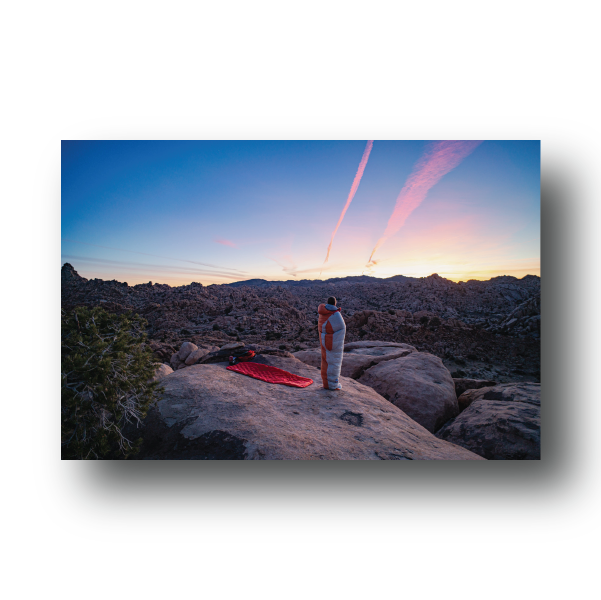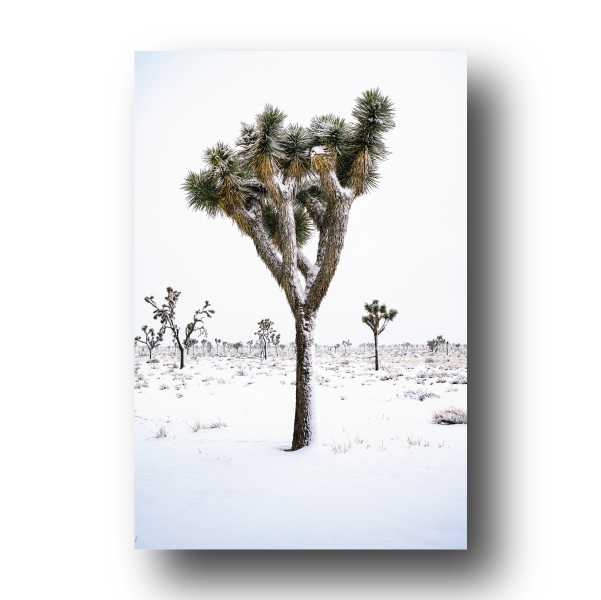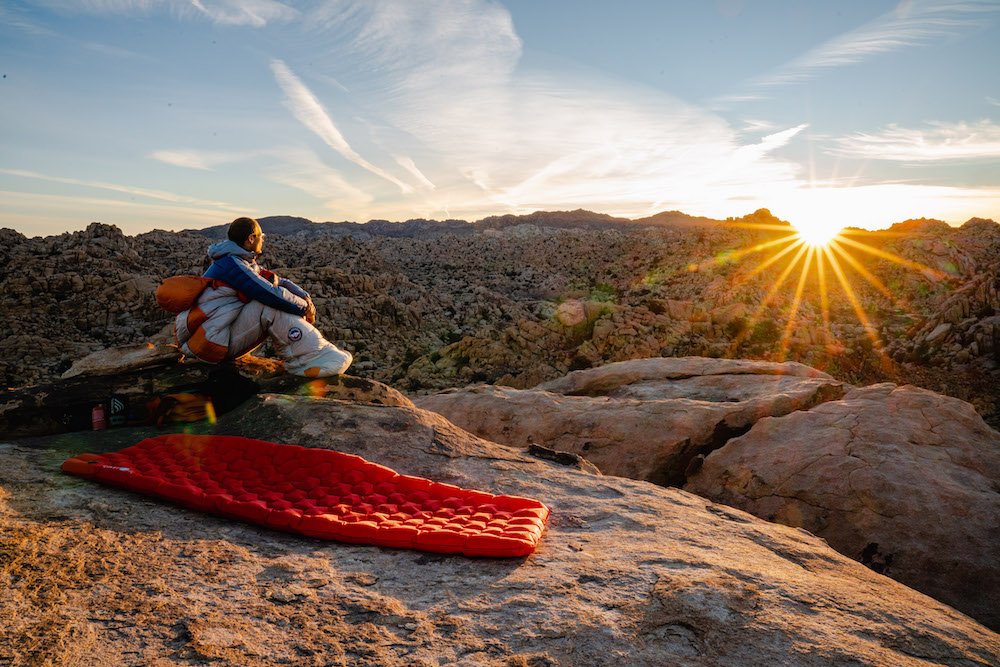Welcome to the enchanting desert wonderland of Joshua Tree National Park, where otherworldly landscapes, unique flora and fauna, and awe-inspiring rock formations await your exploration. Nestled in southeastern California, Joshua Tree National Park spans across two distinct desert ecosystems—the Mojave and Colorado Deserts—offering a treasure trove of natural beauty and recreational opportunities.
Whether you're an avid hiker, a rock climber seeking adventure, or simply a nature enthusiast, this ultimate visitor's guide will equip you with everything you need to make the most of your visit to this remarkable national park.
Highlining in Joshua Tree National Park. Photo by Dalton Johnson
Pros
Stunning Natural Beauty: Joshua Tree National Park boasts unique desert landscapes, iconic Joshua Trees, captivating rock formations, and vibrant wildflower blooms in the spring, making it a paradise for nature enthusiasts and photographers.
Outdoor Activities: The park offers a wide range of activities, including hiking, rock climbing, stargazing, birdwatching, and photography, ensuring there's something for every outdoor enthusiast.
Rock Climbing Paradise: Joshua Tree is a world-renowned rock climbing destination, with thousands of climbing routes catering to climbers of all skill levels.
Stargazing: The park's remote location and minimal light pollution make it an exceptional place for stargazing. On clear nights, you can witness a spectacular display of stars and celestial wonders.
Cultural and Historical Significance: Explore the Native American heritage and early settler history, with historical sites and remnants of mining operations within the park.
Leave No Trace Principles: The park promotes responsible tourism, encouraging visitors to leave no trace and preserve the fragile desert ecosystem.
Wildlife and Flora: Encounter unique desert wildlife, including desert tortoises, bighorn sheep, and a diverse range of bird species. The park's flora, including Joshua Trees and cacti, adds to its charm.
Nearby Towns: Nearby towns like Joshua Tree, Twentynine Palms, and Yucca Valley provide accommodation, dining, and shopping options for visitors.
Cons
Extreme Temperatures: Joshua Tree experiences extreme temperature fluctuations, with scorching summers where daytime temperatures can exceed 100°F (38°C) and chilly winters with freezing nighttime temperatures.
Summer Heat: Visiting during the summer months can be challenging due to the intense heat, making outdoor activities less comfortable and potentially dangerous.
Limited Water Sources: Water sources within the park are limited, so visitors must carry an ample supply of water, especially when hiking or camping.
Crowds: The park can become crowded, particularly during peak seasons (fall and spring), which may limit the sense of solitude and parking availability.
Lack of Services: While there are visitor centers and some amenities, services within the park can be limited, with no restaurants or gas stations, so planning ahead is crucial.
Primitive Campsites: Some campgrounds in the park offer limited amenities, such as pit toilets and no showers, which may not suit all travelers.
Remote Location: The park's remote location means limited cell phone reception in many areas, making it essential to be self-sufficient and prepared.
Light Pollution: While the lack of light pollution is excellent for stargazing, it can be challenging for those who rely on electronic navigation or communication devices.
Getting There
Directions
Getting to Joshua Tree National Park is relatively straightforward, but planning ahead is essential. The park is located about 140 miles east of Los Angeles and 215 miles southwest of Las Vegas.
From Los Angeles:
Take I-10 East and exit onto California Highway 62 (Twentynine Palms Highway).
Follow CA-62 to the park's West Entrance in Joshua Tree Village.
From Las Vegas:
Take I-15 South to the town of Baker, then head west on CA-127 South.
Merge onto I-40 West and follow it to CA-95 South.
Continue on CA-95 South to CA-62 West (Twentynine Palms Highway) to reach the park's West Entrance.
Park Hours and Fees
Joshua Tree National Park is open 24 hours a day, year-round. However, some park facilities and roads may close during extreme weather conditions, so it's wise to check the park's official website for the latest updates before your trip.
Entrance Fees:
Private Vehicle: $30 for a 7-day pass
Motorcycle: $25 for a 7-day pass
Individual (on foot or bicycle): $15 per person for a 7-day pass
Annual Pass: For those planning multiple visits to national parks, the America the Beautiful Pass, available for $80, provides unlimited access to Joshua Tree National Park and other federal recreational lands for one year.
Best Time to Visit
The best time to visit Joshua Tree National Park depends on your preferences and tolerance for weather conditions. Generally, the fall (October to November) and spring (March to May) seasons offer milder temperatures and pleasant weather for most outdoor activities. Winters (December to February) can be chilly, especially at night, while summers (June to August) can be scorching, with daytime temperatures often exceeding 100°F (38°C).
If you're planning outdoor activities, such as hiking or rock climbing, it's advisable to visit during the cooler months to avoid extreme heat. Keep in mind that certain wildflower blooms occur in the spring, adding vibrant colors to the desert landscape.
Park Basics
Visitor Centers
To start your journey, consider a visit to one of the park's visitor centers. These centers provide valuable information, maps, and exhibits to help you make the most of your visit. The primary visitor centers are:
1. Joshua Tree Visitor Center (Oasis Visitor Center):
Location: Joshua Tree Village (West Entrance)
Services: Information, exhibits, and ranger programs.
2. Joshua Tree National Park Visitor Center:
Location: Twentynine Palms (North Entrance)
Services: Information, exhibits, and ranger programs.
Accommodation Options
Depending on your preference and the level of comfort you seek, Joshua Tree National Park offers various accommodation options:
1. Campgrounds:
The park features several campgrounds, some of which are first-come, first-served, while others accept reservations. Key campgrounds include Belle, Hidden Valley, Jumbo Rocks, and White Tank.
2. RV Parks:
If you're traveling with an RV, there are RV-friendly campsites available in the park, complete with facilities for hookups.
3. Lodging in Nearby Towns:
Joshua Tree, Twentynine Palms, and Yucca Valley are nearby towns with various lodging options, including hotels, motels, and vacation rentals.
Keep in mind that campgrounds can fill up quickly during the peak season (fall and spring), so reservations are recommended if you plan to camp.
Attractions and Points of Interest
Joshua Trees and Unique Flora
One of the park's iconic features is, of course, the Joshua Tree (Yucca brevifolia). These quirky, otherworldly trees are native to the park and provide an eerie, yet captivating backdrop to your visit. Take a moment to appreciate their unique characteristics and the sense of timelessness they evoke.
Geological Marvels
Joshua Tree National Park is renowned for its mesmerizing rock formations, formed over millions of years. Notable formations include:
Skull Rock: This famous rock formation resembles a skull and is easily accessible from the main road.
Arch Rock: A short hike leads you to this natural arch formation, ideal for photography.
Wonderland of Rocks: A vast area offering endless exploration opportunities for rock climbers and hikers.
Hiking Trails
The park boasts a wide range of hiking trails, catering to all skill levels. Some popular hikes include:
Ryan Mountain Trail: A moderately strenuous hike leading to panoramic views of the park.
Hidden Valley Nature Trail: A short, easy loop trail surrounded by towering rock formations.
Lost Horse Mine Trail: Explore the history of the park with a hike to a well-preserved gold mine.
Barker Dam Nature Trail: A family-friendly trail featuring petroglyphs, a seasonal desert lake, and excellent birdwatching opportunities.
Rock Climbing
Joshua Tree National Park is a mecca for rock climbers, with thousands of climbing routes across various formations. If you're an experienced climber, the park's unique granite rock formations provide an exhilarating challenge. However, ensure you follow safety protocols and check the latest climbing regulations.
Scenic Drives
For a leisurely exploration of the park's beauty, consider taking one of the scenic drives:
Keys View Road: Drive to the Keys View overlook for panoramic vistas of the Coachella Valley, Salton Sea, and San Andreas Fault.
Pinto Basin Road: Enjoy the diverse desert landscape as you traverse from the Mojave Desert to the Colorado Desert.
Geology Tour Road: This unpaved road offers insight into the park's geological features.
Must-See Landmarks
Don't miss these iconic landmarks:
Keys View: Witness unforgettable sunsets and sweeping vistas of the Coachella Valley.
Cholla Cactus Garden: Visit this garden at sunrise or sunset when the light showcases the Cholla cacti's spiny beauty.
Skull Rock: As mentioned earlier, this rock formation is a must-see attraction easily accessible from the road.
Activities
Hiking
With over 100 miles of hiking trails, Joshua Tree National Park is a hiker's paradise. Before setting out on a hike, ensure you're adequately prepared with sufficient water, sturdy footwear, and a map of the trail.
Rock Climbing
For rock climbers, Joshua Tree offers a diverse range of climbing opportunities, from easy bouldering routes to challenging multi-pitch climbs. Consider joining guided climbing tours if you're new to the sport or the park.
Stargazing
The park's remote location and minimal light pollution make it an exceptional destination for stargazing. On clear nights, the desert skies come alive with an astonishing display of stars. Bring a telescope or simply lay out a blanket and gaze up at the cosmos.
Birdwatching
Joshua Tree National Park is a birdwatcher's paradise, with over 250 species of birds. The Barker Dam area is particularly good for spotting birdlife. Keep an eye out for the park's resident raptors, including hawks and eagles.
Photography
The park's surreal landscapes, striking rock formations, and unique desert flora provide endless opportunities for photographers. Be sure to capture the park's beauty during the golden hours of sunrise and sunset.
Safety Guidelines
Extreme Temperatures
Joshua Tree National Park experiences extreme temperature fluctuations, especially in the summer and winter months. Be prepared for scorching daytime heat and chilly nights. Carry plenty of water, sun protection, and layered clothing to accommodate these changes.
Wildlife Encounters
While exploring the park, you may encounter a variety of wildlife, including desert tortoises, bighorn sheep, and rattlesnakes. Maintain a respectful distance from all animals and never feed them. Store food securely to avoid attracting wildlife to your campsite.
First Aid
Pack a basic first-aid kit and know how to use it. Cell phone reception can be unreliable in some areas of the park, so it's essential to be self-sufficient when it comes to medical care.
Desert Hiking and Camping
If you plan to hike or camp in the desert backcountry, inform someone of your plans and expected return time. Carry sufficient water, a map, a compass, and other essential supplies. Familiarize yourself with desert hiking safety techniques.
Wildlife and Flora
Desert Flora
Explore the diverse desert flora, which includes not only Joshua Trees but also creosote bushes, ocotillo, yuccas, and various cacti species. The Cholla Cactus Garden is a must-visit spot for cactus enthusiasts.
Desert Wildlife
Keep an eye out for the park's unique wildlife, such as desert tortoises, bighorn sheep, coyotes, and roadrunners. Birdwatchers will delight in spotting avian species, including Gambel's quail, phainopeplas, and Western bluebirds.
Weather and Climate
Climate
Joshua Tree National Park experiences a desert climate characterized by hot summers and mild winters. Here's a general overview of the climate:
Summer (June to August): Daytime temperatures often exceed 100°F (38°C), while nights are cooler. Be prepared for intense heat if visiting during these months.
Fall (September to November): Temperatures begin to moderate, making this a popular time for visitors.
Winter (December to February): Daytime temperatures range from the 60s to 70s°F (15-25°C), while nights can drop to freezing or below. Winter visitors should dress warmly for chilly evenings.
Spring (March to May): Mild temperatures and blooming wildflowers make this an ideal time for hiking and exploring.
Dressing Appropriately
Given the climate fluctuations, it's crucial to dress appropriately. Wear lightweight, breathable clothing in the summer and layer up in the winter. Sun protection, including hats and sunscreen, is essential year-round.
Cultural and Historical Significance
Native American Heritage
The area now encompassed by Joshua Tree National Park has a rich Native American history, with various tribes, including the Serrano, Chemehuevi, and Cahuilla, having inhabited the region for thousands of years. Respect the cultural heritage of the area and avoid disturbing or removing any archaeological or historical artifacts.
Early Settlers
European settlers arrived in the 19th century, and you can still find remnants of their homesteads and mining operations within the park. The Lost Horse Mine and Wall Street Mill are two sites that offer insights into this history.
Leave No Trace Principles
As you explore Joshua Tree National Park, follow the Leave No Trace principles to minimize your impact on the environment:
Plan Ahead and Prepare: Research the park, know the regulations, and be prepared with appropriate gear and supplies.
Travel and Camp on Durable Surfaces: Stick to designated trails and campsites to minimize damage to fragile desert ecosystems.
Dispose of Waste Properly: Pack out all trash and waste, including human waste if camping in the backcountry.
Leave What You Find: Avoid disturbing plants, wildlife, and historical or archaeological sites.
Minimize Campfire Impact: Use a camp stove for cooking, as fires are only allowed in designated areas and subject to seasonal restrictions.
Respect Wildlife: Keep a safe distance from animals, and never feed them.
Be Considerate of Other Visitors: Keep noise levels down, yield the trail to others, and follow posted regulations.
Photography Tips
Sunrise and Sunset
For the best lighting conditions and dramatic landscapes, plan to photograph the park during the golden hours around sunrise and sunset.
Stargazing Photography
Capture the park's stunning night sky by using a tripod for long exposures. Experiment with different camera settings to capture the stars and Milky Way.
Unique Angles
Get creative with your photography by exploring unique angles and perspectives to showcase the park's extraordinary rock formations.
Local Eateries and Services
Joshua Tree Village
The village just outside the West Entrance offers a selection of restaurants and cafes where you can refuel after a day of exploring. Consider trying local dishes and desert-inspired cuisine.
Groceries and Supplies
Stock up on supplies in Joshua Tree, Twentynine Palms, or Yucca Valley if you plan to camp or cook during your visit. These towns have grocery stores and shops where you can purchase food, water, and camping equipment.
Nearby Attractions
While Joshua Tree National Park is the primary attraction in the area, there are several other points of interest worth exploring in the vicinity:
Joshua Tree Music Festival: If you time your visit right, you might catch a local music festival, showcasing the region's music talent.
Joshua Tree Music Arts & Film Festival: A celebration of music, art, and film, this event offers a unique cultural experience.
Pioneertown: Visit this Old West-style movie set turned tourist attraction, where you can explore mock gunfights, shops, and restaurants.
Joshua Tree National Park Association Bookstore: Located within the Joshua Tree Visitor Center, this bookstore offers books, maps, and educational materials to enhance your park experience.
Hi-Desert Nature Museum: Located in Yucca Valley, this museum provides insights into the natural history of the region.
Bouldering in Joshua Tree National Park. Photo by Dalton Johnson
Your visit to Joshua Tree National Park promises to be a journey of discovery, where you'll encounter breathtaking landscapes, engage with unique flora and fauna, and embark on memorable outdoor adventures. Whether you're an avid hiker, a rock climbing enthusiast, or simply someone seeking solace in the desert's tranquility, this ultimate visitor's guide equips you with the knowledge and tips to make your visit safe, enjoyable, and unforgettable. Embrace the stark beauty of Joshua Tree National Park, and let the desert's magic captivate your soul.
Remember, while this guide provides comprehensive information, it's essential to stay updated on park regulations and conditions by visiting the official Joshua Tree National Park website or contacting park rangers. So, pack your gear, grab your camera, and set out to explore the wonders of Joshua Tree—a true gem among America's national parks.







